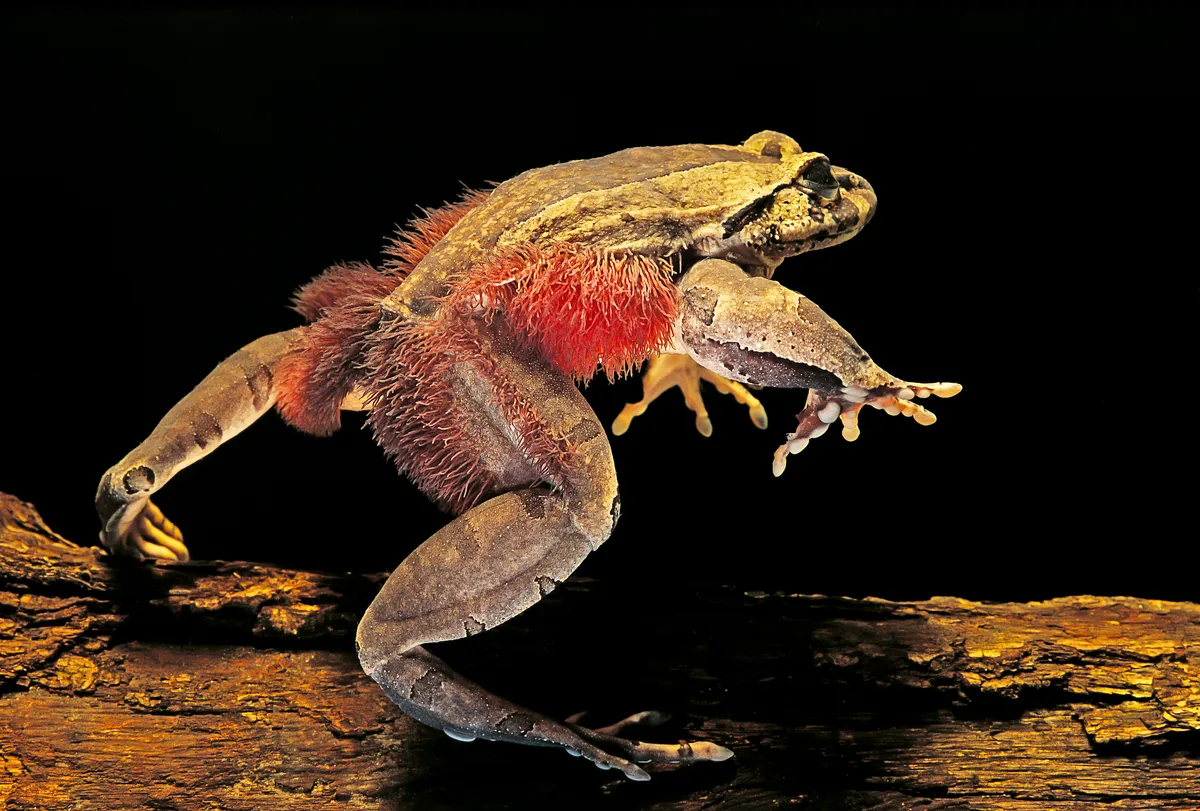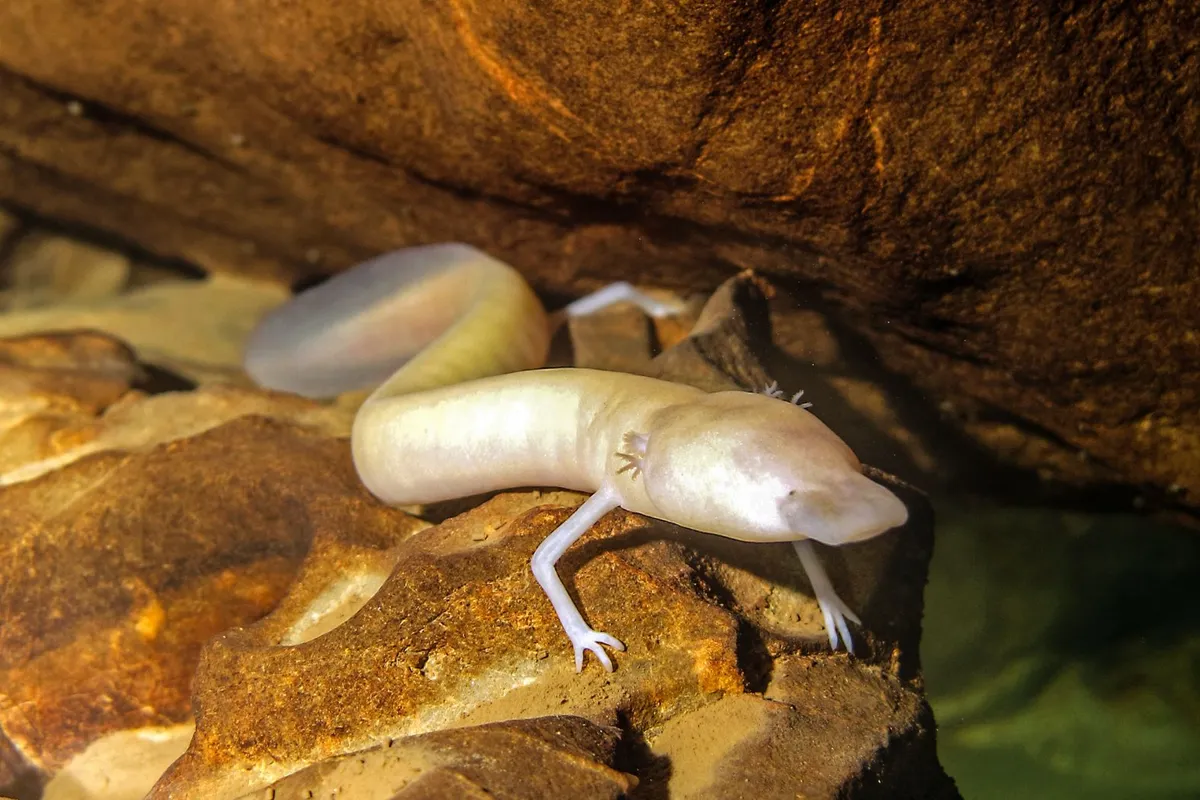Amphibians are anything but boring – and many species are downright bizarre. From frogs that give birth through their backs to newts that fire poison from their own bones, these animals rank among the strangest creatures on the planet.
- Amphibian vs reptile: what's the difference?
- Lizard vs newt: Just what's the difference between these 2 similar looking – but worlds apart – species...?
Weirdest amphibians on the planet
Surinam toad

A South American frog whose young erupt from the mother’s back. Called (confusingly) the Surinam toad, it is the most un-frog-like frog you are ever likely to see, if you can see it at all – it is a master of camouflage.
- Meet the strange Surinam toad, an alien-like South American frog whose live young burst out through holes in its back
- Weirdest ways animals give birth – are these the 10 craziest animal births ever?
Reproduction is weird, too. While the mother is laying up to 100 eggs, the male fertilises them. The sticky spawn is then caught on the female’s back and the male spreads it out with gentle stokes of his rear legs. Within 24 hours the eggs sink into the spongy flesh, eventually becoming embedded and sealed over. Safe under her skin, they hatch and develop into tadpoles.

Once they near emergence, the female's thin skin bulges and pulsates with the struggles of the impatient froglets. The day comes when she gives a shrug and the cells rupture, releasing tiny but perfectly formed Surinam toads.
Penis snake

You probably haven't heard of the Atretochoana eiselti before, but you may have heard what some call it – the penis snake. While it's not too difficult to see why it got that charming moniker, it's not actually a snake but a caecilian – a limbless amphibian.
Caecilians live hidden in soil or streambeds, feeding on insects and earthworms. A particularly fascinating (or gross, depending on how you see it) fact about these amphibians is that after giving birth some species allow their young to feed on a special outer layer of their own skin, which the hatchlings peel off with specially modified teeth.
Atretochoana eiselti is not one of these species but is the only known lungless caecilian and in fact the largest tetrapod to lack lungs.
We named it one of the weirdest animals in the world as well as one of the weirdest snakes
Hairy frog

A frog with fur? And sharp, cat-like claws? Either might sound improbable, and Africa’s hairy frog Trichobatrachus robustus is certainly stranger than fiction. This 11cm-long frog is hairy during the mating season, when the male develops a thick bristle-like fringe along his flanks and thighs.
It also has rather a clever survival trick. With the flex of a foot muscle, it can produce an arsenal of sharp, curved claws that snap out of its toes like switchblades.
Olm

Olms, cave-dwelling salamanders, have been surrounded by mystery for centuries. Local people often saw the olms after heavy rains washed them from the caves, and believed they were the offspring of 'cave dragons'.
With the olm's sinuous body and external gills, it’s not too difficult to understand this particular case of mistaken identity.
Unlike the majority of amphibians, the olm is completely aquatic, and like all troglobites (true cave-dwelling creatures), it is adapted to living its whole life in the darkness of caves. It lacks any pigmentation in its skin, resulting in it being a pink or yellow-white colour and being given the nickname ‘human fish’.
Olms are about 30cm (12in) long and are one of the weirdest animals in the world.
Spanish ribbed newt

The Spanish ribbed newt has one of the most spectacular defence mechanisms out there. When threatened by a predator, Pleurodeles waltl takes spectacular offensive action. Not only does it exude a milky poisonous fluid from glands in its skin, it also has the perfect apparatus to administer it.
It has orange spots along its flanks, through which its ribs can protrude. By flattening its body and arching its back, the newt swings its ribs forwards so that they are perpendicular to its spine. The ribs stretch the skin to the point that they burst right through it, producing a row of barbs down each flank that inject poison into any predator foolish enough to venture too close.
Once the danger has passed, the amphibian simply pops its ribs back inside its body. And thanks to its famous powers of regeneration, Pleurodeles waltl can puncture its skin repeatedly, with apparently no ill effects.
Flying frog
Borneo is home to more species of gliding animal than anywhere else on Earth. One of the most famous is Wallace's flying frog, named after the famous naturalist. It glides using its huge webbed feet, which enable it to control its descent and even steer in mid-air.
Rain frog

Rain frogs glue themselves together when mating. Unlike most frogs, who lay eggs in water, rain frogs lay them underground. And if the male isn't firmly attached to his partner during the burrowing process, he is likely to be dislodged before the eggs are laid and fertilised.
Yet the glue doesn't always allow for the perfect pairing. It is not unknown for males to get stuck in the wrong position – back to front, or sideways on – or for groups of individuals to become hopelessly welded together in the scrum for mates.
- Meet the world’s largest frog that's a whopping 30cm long
- The world's bizarrest frogs you (probably) haven't heard of - from ultrasonic screamers to a species that glue themselves together when mating
- There's a bizarre frog in the Amazon rainforest that screams at predators to scare them away. Listen, if you dare…
- The bizarre paradoxical frog shrinks as it grows up – and could help treat diabetes in humans






